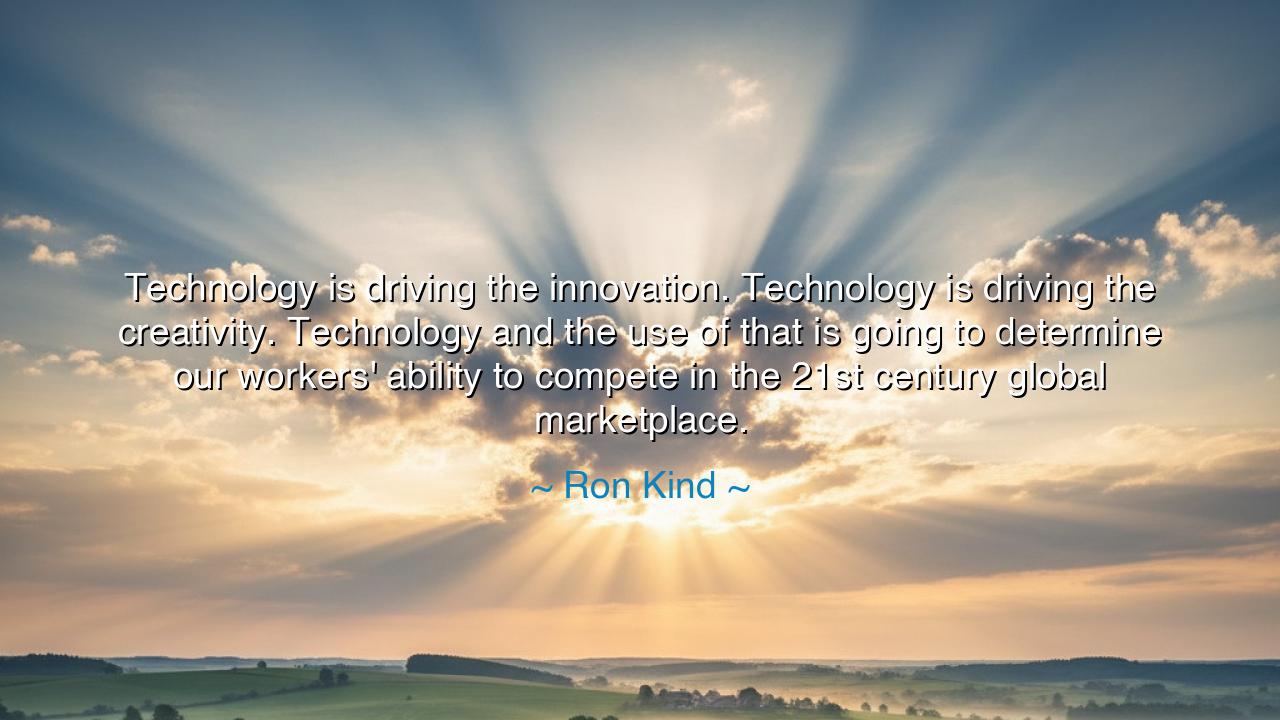
Technology is driving the innovation. Technology is driving the
Technology is driving the innovation. Technology is driving the creativity. Technology and the use of that is going to determine our workers' ability to compete in the 21st century global marketplace.






The words of Ron Kind, “Technology is driving the innovation. Technology is driving the creativity. Technology and the use of that is going to determine our workers' ability to compete in the 21st century global marketplace,” resound as a clarion call for vigilance and foresight. He speaks to the undeniable force of technology as both a catalyst and a compass, shaping not only the tools we use but the very capacity of human ingenuity. In Kind’s vision, innovation and creativity are inseparable from technological mastery, and the ability of workers to thrive hinges upon their engagement with this ever-accelerating current of change.
The origin of this insight lies in Kind’s life as a legislator and advocate for workforce development in an increasingly globalized economy. Observing the transformations wrought by computing, telecommunications, and automation, he recognized that workers who failed to harness technology would be left behind in the competitive arenas of the 21st century. His words are both warning and guidance: mastery of tools is not mere convenience—it is the lifeblood of innovation, creativity, and economic survival.
History provides vivid parallels to this truth. During the Industrial Revolution, the introduction of steam engines, mechanized looms, and ironworks transformed societies. Those who mastered the new technology thrived, creating wealth, advancing infrastructure, and shaping modern economies. Conversely, those who clung only to old methods were displaced. Kind’s statement echoes this lesson: technology drives progress, and human adaptation to it determines who flourishes in the global marketplace.
Even more recently, the rise of information technology and digital platforms illustrates the transformative power of tools. Software developers, data analysts, and engineers who embraced computing innovations became leaders in their fields, generating economic value and redefining productivity. Kind emphasizes that creativity itself is amplified by technology: new tools unlock new approaches, insights, and products that would be unattainable without them. The modern worker’s competitive edge is inseparable from their ability to integrate technology into their craft.
The meaning of Kind’s words extends beyond economics; they are a meditation on human adaptability and ingenuity. Technology is neither neutral nor passive—it shapes possibilities and sets the boundaries of achievement. By mastering these forces, workers and societies can channel them into innovation, problem-solving, and artistic creation. Failure to adapt, however, limits potential and relegates talent to obsolescence, demonstrating that technological fluency is both a skill and a responsibility.
The lesson is timeless: to thrive in any era, one must embrace the tools that define it. Workers, leaders, and communities must cultivate not only knowledge but also technological literacy and agility, blending human insight with mechanical and digital power. Kind’s insight reminds us that progress favors those who integrate innovation into practice, turning tools into instruments of mastery rather than objects of passive use.
Practical action flows naturally. Invest in education and training that prioritizes technology and innovation. Encourage curiosity and experimentation in the use of new tools. Adapt workflows and industries to harness the potential of emerging technologies. Support policies and initiatives that empower workers to develop skills that are globally competitive, ensuring that innovation and creativity flourish hand in hand.
Thus, let Ron Kind’s words endure as guidance for the generations: technology drives innovation, creativity, and competitiveness in the global marketplace. Those who embrace its power, skillfully and imaginatively, shape their destiny and the destiny of society. By mastering tools, adapting to change, and cultivating creativity, we ensure that human potential is magnified rather than constrained, and that progress remains a force for growth, prosperity, and enduring achievement.






AAdministratorAdministrator
Welcome, honored guests. Please leave a comment, we will respond soon